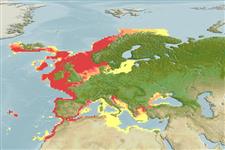Common names from other countries
Classification / Names / Names
ماع يماسا | فدارتم | Catalog of Fishes (gen., sp.) | ITIS | CoL | WoRMS
Environment: milieu / climate zone / depth range / distribution range
يسانش موب
; قمع تارييغت 0 - 619 m (Ref. 105829). Subtropical; 83°N - 27°N, 127°W - 36°E
Arctic, Eastern Atlantic and the Mediterranean Sea: from Canadian Arctic to Iceland, Norway, Sweden, south to Morocco, Madeira Island and Canary Islands, and the Mediterranean. Polar to subtropical.
Length at first maturity / Size / Weight / نس
Maturity: Lm ? range ? - ? cm Max length : 7.5 cm SHL يسنج صاوخ نودب / رن سنج; (Ref. 128384)
Exists at the front (Ref. 122115). Inhabits fine sand (Ref. 106083). Common in sandy-muddy deposits (Ref. 105826). Found in an estuary (Ref. 105814) and associated with coralligenous formations (Ref. 122117). Abundant in detritic bottoms (Ref. 122133). This is a sessile-burrower suspension feeder (Ref. 96498). Feeds on phytoplankton and suspended organic material (Ref. 106986).
Life cycle and mating behavior
غولب | لثم دیلوت | یزیر مخت | اه مخت | Fecundity | )ورال ( دازوت
Members of the class Bivalvia are mostly gonochoric, some are protandric hermaphrodites. Life cycle: Embryos develop into free-swimming trocophore larvae, succeeded by the bivalve veliger, resembling a miniature clam.
یلصا ذخآم
عجارم | هدننك گنهامه | ناراكمه
FAO. 2007. (Ref. 78075)
NCUI زمرق تسرهف رد تيعضو (Ref. 130435)
ستياس رظن زا تيعضو (Ref. 108899)
Not Evaluated
Not Evaluated
یناسنا هدافتسا
تاليش – يريگ يهام: يراجت
| FishSource |
اهرازبا
رتشيب تاعالطا
Age/Sizeدشرنزو - لوطلوط - لوطيسانش تخير)ورال ( دازوتيناوارف
يتنرتنيا عبانم
Estimates based on models
Preferred temperature
(Ref.
115969): 6.8 - 14.2, mean 9.7 (based on 503 cells).
